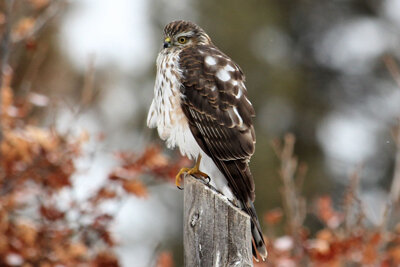
This week’s Bird of the Week, compliments of the Weminuche Audubon Society and Audubon Rockies, is the sharp-shinned hawk.
This smallest member of the accipiter family of birds is built for flight that is fast and acrobatic. Short wings and a long tail that functions as a rudder allow accipiters to make tight turns and sharp dives while flying through the small openings of their forested habitats. In contrast, hawks in the buteo family, like the familiar red-tailed, with short tails and long, wide wings, are designed for soaring.
Depending on location, sharp-shinned hawks are either resident or long-distance migrants. Those that breed in Canada and the northern United States may migrate as far as Central America for the winter. We are within their year-round range. Often out of sight, they nest and raise their young in densely forested areas with a closed canopy. In winter they may move to forest edges for better hunting.
Ninety percent of a sharpie’s diet is songbirds, usually robin-sized or smaller. Stealth and surprise followed by fast pursuit enter into its hunting strategy. They are equipped with long toes and talons to impale and hold onto struggling prey. Sharp vision and the ability to process visual information much faster than we can allows them to avoid obstacles and track prey while in high speed chase.
Adult sharp-shinned hawks are slate blue-gray above and have narrow, red-orange barring across their breasts. Their long tails have broad, dark bands and are square tipped. The yellow eye color of brown immature birds changes to red in adults. Even experienced bird watchers have difficulty distinguishing the sharp-shinned from the Cooper’s hawk, which appears nearly identical. The Cooper’s looks more square-headed, has a dark cap and its tail appears more rounded, but these differences are often hard to see.
If bird feeders attract songbirds to your yard, don’t be surprised to have a sharpie show up looking for a meal. If one becomes a regular visitor, you may have to take your feeders down for a couple of weeks to encourage it to move on.
For information on events, visit www.weminucheaudubon.org and www.facebook.com/weminucheaudubon/.